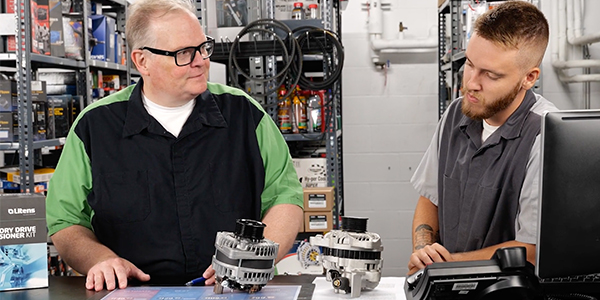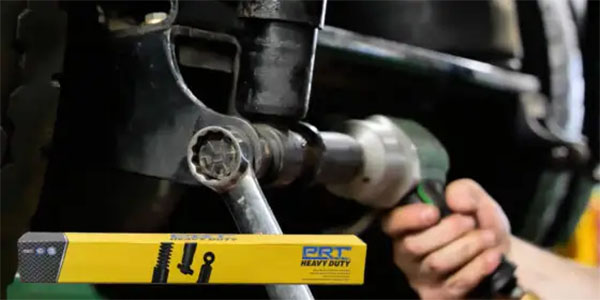CC:
Technician: “I don’t think this is the correct alternator for the customer’s vehicle. This is the alternator I removed, and this is what came in the box.”
Shop Owner: “I don’t see the difference.”
-The technician turns the alternator around so the nose and pulley of the alternators are facing the shop owner.
Shop Owner: “I see the pulleys don’t match. Do you think it will be a problem?”
Technician: “It will fit, but it is not an OAD pulley.”
Scene:
-Product expert is standing in front of a truck with the hood up.
The Expert: Has this ever happened to you? For some parts, the replacement might not look the same as the original, like filters and brake pads. But when it comes to the alternator pulley, don’t take any chances.
The original alternator removed by the technician was equipped with an over-running alternator decoupler pulley or OAD made by Litens. An OAD pulley is designed to decouple the alternator from the accessory drive belt system and absorb vibrations from the engine and the other components of the belt drive system.
While a solid pulley can transfer the movement from the belt to the alternator’s rotor, the absence of the OAD will impact the efficiency and longevity of the entire belt drive system.
Let’s look inside an OAD. There are three technologies inside that help to decouple the alternator and dampen vibration. The first component is the one-way clutch. The clutch disengages the rotating mass of the alternator when the engine is decelerating to improve the engine’s efficiency. Next is the isolation spring that absorbs the power pulses of the crankshaft and sudden loads caused by events like an AC clutch engagement or sudden loads put on the alternator.
Next, these thrust washers and plastic inserts act like a shock absorber for the spring to dampen pulses from the engine and vibrations in the belt drive system.
All three work together with the belt system and are tuned for the specific application ranging from a large diesel engine to a small gasoline four-cylinder engine.
There are other styles of decoupler pulleys. This is OAP or overrunning alternator pulley. It also has a one-way clutch. But, it lacks the spring and thrust washers to dampen vibrations.
While they look the same outside, the two technologies are incompatible.
How do you tell the difference? The first tipoff is the dust cap. An OAD will have a cap that resides in the lip of the bore like this. An OAP might not have a cap or it is held onto the outside of the pulley with tabs or fingers like this.
With the cap off, you can test the pulley. An OAD will spring back in one direction when force is applied to the alternator’s shaft and freewheel in the other direction. An OAP will lock in one direction and spin in the other, just like a socket wrench.
So, what would happen if our shop owner and technician decide to go with the solid alternator pulley or OAP instead of an OAD?
Since the solid pulley or OAP lack the components to dampen vibrations, his will impact the life of the belt and the health of the other component of the accessory belt drive system. The driver may experience vibration that could translate into noise. The customer may say the noise or vibration is intermittent or only occurring during acceleration.
While an OAP or solid pulley will not leave their customer by the side of the road in the coming months, it will cause extra stress on the accessory drive-belt system and even the engine. The results might be a premature failure of the alternator and decreased belt stability that could result in premature wear and failure of the belt and tensioner.
I know you are thinking, could the technician just transfer the OAD from the old alternator to the new alternator? This is a bad practice because an OAD is a wear component. During the part’s life, the spring will fatigue and the thrust washers will lose their ability to dampen the motion of the pulley. This is why many OEMs recommend replacing the OAD and tensioner with the belt as part of a mileage-based service in the maintenance schedule.
Even if replacement of the OAD is not listed in the maintenance schedule, it is recommended you treat the accessory belt drive components as a system when one component needs replacement. Think of it as a “reset” for the accessory belt drive system where the components are returned to the original condition from the factory. By taking this approach, you can ensure the belt and connected components will work as a system and meet the next replacement interval.
Back to our technician and shop owner.
Scene: Shop owner and tech standing at the front counter.
Shop Owner: “I guess you are right. Let me order another alternator with the correct OAD pulley.”
Technician: While you are ordering parts, see if you can order a new belt, idler pulley and tensioner.with a belt, tensioner and idler pulleys.
Shop Owner: Good call! Looking at the mileage on the repair order and service interval, it is due.
Technician: Thanks, customers forget that when one component fails or is worn, chances are, the others should be replaced as well. A full system reset will assure optimal performance and prevent a comeback.
Shop Owner: That should be an easy sell to the customer, as they wouldn’t want to come back just to have the belt replaced and end up paying for additional labor charges.
This video is sponsored by Litens.














